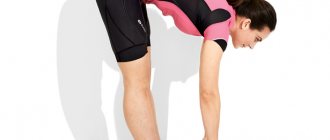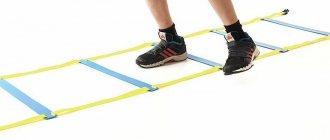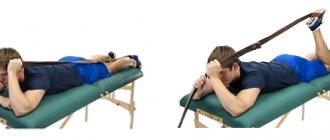A fight in the ring according to the rules of classic boxing requires good physical preparation. You don't have time to catch your breath. There is no way to lower your hands, shake yourself, or wipe the blood or sweat from your face. You need to have an excellent sense of your body, know your weak points and see the weak points of your opponent.
Boxing is the loneliest sport, the most mentally and physically difficult. Your body is being abused. It's not like running a distance, swimming in a pool, or throwing a ball into a basket. You must always be 100% ready.
Emanuel Steward
trainer of professional boxers and commentator of boxing matches
The main qualities that a fighter needs are explosive strength and anaerobic endurance. Strength is needed to strike quickly and powerfully. Anaerobic endurance is necessary to avoid enemy blows and deliver your own. A boxer's training is based on these two factors.
If you don't practice martial arts yourself, training on bags and shadow boxing is unlikely to be useful to you. At the same time, a number of exercises that boxers love and practice are sure to fit into your workout and help you get in shape.
Examples of legends
Behind the success of stars lies a lot of work and adherence to a strict regime. The following are examples of the training of great boxers:
- Muhammad Ali.
- Mike Tyson.
- Roy Jones Jr.
Ali's training day began with a forty-minute run. He covered 10 km. Then came simple warm-up exercises and stretching. After them, take a shower and eat.
10 weeks before the scheduled match he was doing 3-4 runs per week. Distances: 5 – 10 km. 10 days before the battle they stopped. The boxer ran wearing heavy soldier boots.
Ali did not disturb his sleep schedule: from 22.30 to 5.30. And the full schedule of his day is reflected in this table:
| Schedule | Start | Duration (min.) |
| Run 10 km | 5:30 | 40 |
| Warm-up | 6:10 | ~ |
| Shower | ~ | ~ |
| Breakfast | ~ | ~ |
| Class in the hall | 12:30 | 180 |
| Massage | 14-30 | ~ |
| Shower | 15.00 | ~ |
| Dinner | 19.30 | ~ |
| Leisure | 20.00 | ~ |
Each subsequent lesson had no serious differences from the previous one, with the exception of special adjustments to the future opponent. Ali trained while his opponent was asleep. His program included the following components:
First: warming up. Basic exercise lasting 15 minutes. A reliable way to protect the body and knees. Includes the following items:
- The leg moves from one side to the other.
- Torso rotation.
- Weak jumping in a circle. The socks are extended.
Second: shadow boxing. Priority is given to footwork and dynamics. Duration: 5 laps of 3 minutes. After each break - 30 seconds.
Third: working with a massive pear. This is where series and endurance are worked out. They are given 6 cycles of 3 minutes each. Pause – 30 sec.
Fourth: sparring. I settled with one or another partner depending on the future opponent and current physical condition.
Fifth: floor work. Lasts 15 minutes. 300 repetitions are arranged. It includes the following items:
- imitation of pedaling while lying on your back,
- lifting the body from a similar position,
- squats with a bag,
- leg raises.
Sixth: exercises with a pneumatic bag. Duration – 9 minutes. Number of pauses – 1.
Seventh: jumping rope. This requires constant movement.
Eighth: fight with the shadow. Lasts 1 minute, but you need to move in a circle.
Mike Tyson's program and regime is one of the standards of sports discipline.
This boxer's whole day is training. And this is a daily repeating process. Only a few can master such a schedule. Its details are reflected in the following table:
| Plan | Start | Duration (hours) |
| Run 5 km | 5:00 | 1 |
| Shower | 6:00 | ~ |
| Dream | 6:20 | ~ |
| Breakfast. Definitely an omelette. | 10:00 | ~ |
| Classes in the ring | 12:00 | 2 |
| Dinner. Required: steak, pasta, juice. | 14:00 | 1 |
| Exercise bike. Work at the fastest possible pace. | 15:00 | 2 |
| Physical exercise | 17:00 | 1 |
| Dinner: steak, pasta, juice | 19:00 | 1 |
| Exercise bike. Moderate work. | 20:00 | 0,5 |
| Watching TV and sleeping | 20:30 | ~ |
Experts explained the presence of a monotonous diet and a powerfully stressful day as a legacy of a prison term and a monotonous life.
The class started at noon. The program necessarily included sparring of 10 rounds.
Strength training began at 17.00. It included 10 approaches and performed the following exercises:
- Squats – 2000 times.
- Push-ups: 500 – 800.
- Pull-ups: 200.
- Lifting dumbbells 30 kg. – 500 times.
- Exercises to develop the neck muscles – 10 minutes.
The last block was implemented using the wrestling method. Tyson leaned only on his head, without helping with his hands, and swung around and around.
Basic exercises for a boxer of this level to improve his punch took place on a light bag filled with sand. This is how speed was worked out.
The power was developed on a heavy bag, which the athlete specially swung. In this way he worked with it, constantly moving around it and making deviations.
In his training, Tyson rarely exercised with iron. And his coach was confident that this would bring his ward unique mobility and energy, and would allow him to defeat any opponent.
Roy Jones Jr. will be remembered by boxing fans for his bright and spectacular fights in the heavy and light heavyweight categories. Such results are the fruits of intensive training 6 days a week for an average of 6-7 hours (total 36-42 hours).
Thanks to this schedule, Jones improved his combat speed to incredible levels. He develops endurance through basketball, running, and cycling.
The start time of his classes is early in the morning (at about 5.30). It covers 8-12 km. The distance is affected by his mood and well-being.
Information about his training program is not public. But some information still leaks out in foreign and Russian-language publications. And their versions have a significant difference.
According to Western sources, his program is as follows:
- Start with a full stretch.
- Shadowboxing: 3 rounds.
- Work with a massive pear (from 60 kg) – 6 circles.
- Practicing blows on a pneumatic bag: 3 cycles of 2 minutes each.
- 20-30 minutes of continuous jumping rope.
- Repeat stretching.
- Medicine ball throws to the chest - 20 times.
Russian-language publications provide the following information:
- Warm up.
- Shadowboxing: 4 laps for 4-5 minutes. Each is separated by a pause of 30 seconds.
- 16 minutes of work with a pneumatic bulb.
- 15 minutes of lifting the pear onto a pedestal (height - from 60 cm).
- Jumping rope – 20-25 min.
- Abs pumping.
- Raising the body from a lying position: 4 sets of 100 repetitions.
- Leg raises. Load – identical to point 7
- Sparring. 8-10 rounds.
The athlete’s diet is less saturated compared to other boxing legends. Breakfast consisted of fruit. For lunch: vegetable salad, chicken and pasta. Dinner consisted of protein components, for example, chicken.
Jones has never used chemicals in his entire career. And I have never consumed alcoholic beverages in my entire life.
Boxers warming up
Warm-up is an integral attribute of any workout , allowing you to prepare, stretch and warm up your muscles. Then they become more resilient and obedient, stimulating the work of the internal organs and human brain. It is convenient to learn a certain set of warm-up exercises so that you can perform them almost automatically.
So, a warm-up practice can consist of walking around the hall in a circle, rubbing your ears and face as you go, kneading your hands and neck. While walking, we stretch our arms up, rising on our toes, swing our arms, and rotate with bent arms. We take turns doing crawl swimming exercises. When performing exercises, it is important to breathe rhythmically.
We perform fast walking and running (with side steps, acceleration, herringbone, with your back, imitation of dodging an impact). Walking while restoring your breathing. We take turns delivering strikes while walking (facing forward and backwards), with our elbows bent and our fists held to our faces. We perform bends, swings, body rotations, and stretches.
Recommendations from experienced trainers
Reputable experts give beginners the following advice when creating a personal training program for boxing:
- Avoid curling exercises (for biceps), with the exception of pull-ups, and even those are preferable with a wide grip - with the main load on the “wings”.
- Boxing classes and pumping up muscles in the gym should be performed according to a single schedule and a strict system, correctly combining one with the other. Long breaks between workouts are fraught with serious problems with movement, technique, speed and force of strikes.
- Do boxing, not bodybuilding, that is, only according to the physical training program for a boxer. Consult with boxing trainers, politely refusing assistance from fitness instructors.
Develop explosive strength and strength endurance, which is what boxing classes at home serve. Along with a beautiful figure, you will gain agility, excellent coordination of movements, the power of blows, excellent breathing and a cardiovascular system that will be the envy of the “jocks”.
Work on shells
Work on the paws and with the bag occupies a special place in boxing. If you develop impact force with a heavy bag, then working on your paws allows you to position the equipment correctly. Individual training does this very effectively and quickly, during which the coach can pay a lot of attention to one athlete. Such individual lessons very quickly turn a beginner into a trained fighter. In group classes, the trainer will not physically have time to pay as much attention to each trainee, which is why there is such a difference in the results.
You need to work not only on heavy, but also on light pears, including pneumatic ones. Often, gyms are equipped with wall-mounted punching bags, which allow more students to simultaneously develop punching power. Equipment training can be included in the main part of the training, as well as sparring, which is an integral part of a boxer’s training. Before training, you need to check with a sports doctor - boxing requires good health!
Within the walls of the “YourRevolution1905” club, we are ready to professionally help you learn to box or improve your level as a boxer. Entire sets of exercises developed by certified specialists, nutritional recommendations, “smart” weighing, classes conducted by a Master of Sports in boxing and much more, all this will help you achieve your goal as effectively as possible. For the most effective and quick results, you can train individually (one-on-one with a trainer) or in mini-groups of up to ten people. Come to our classes and we will help you become the best version of yourself!
Peeling a pear correctly
Rest for 5-10 minutes while walking slowly around your home gym and continue boxing by putting on your gloves and walking up to the bag.
Pound the bag with all your heart, following simple rules:
- Starting position – SS;
- Alternate blows - straight left with uppercuts, straight right with side;
- Perform strikes not only individually, but also in series and combinations (straight + from below + side + straight, etc.);
- Get into the middle of the pear;
- Increase the strength and speed of blows gradually;
- If you hit at a fairly fast pace without pauses, you will not only improve your hitting, but also get a good cardio workout .
When practicing for yourself, it is useful to perform strikes first in the SS, then in the PS. But if it’s too inconvenient, it’s not worth it, because classes should bring joy.
Determine how long to exercise on the pear yourself by listening to your precious body. Mild fatigue is mandatory, excessive fatigue should be avoided.
Important: if the bag begins to swing strongly after impacts, it’s time to increase its weight.
SUGAR RAY ROBINSON
Sugar Ray Robinson
American professional boxer who competed in the lightweight, junior welterweight, welterweight, junior middleweight, middleweight, junior middleweight, and light heavyweight categories. World champion in welterweight (1946-1950) and middleweight (1951, 1951-1952, 1955-1957, 1957 and 1958-1960) weight categories. The best boxer of all time, regardless of weight category, according to Ring magazine (2002).
This American athlete was born in 1921 in the town of Ailey, Georgia, under the name Walker Smith Jr. The boy was the third child in the family; his father had to work hard and a lot. After his parents' divorce, Walker ended up with his mother in New York, in the Harlem area.
Studying at school did not work out, and the teenager decided to devote all his energy to boxing. The young fighter was once called by his coach as sweet as sugar. This is how the first part of his nickname appeared. And to participate in underground battles, he borrowed the name and card of his friend, Ray Robinson. This is how the young boxer got his nickname, which would soon become famous. As a featherweight, the athlete won all of his 90 fights, receiving the Golden Gloves award.
Since 1940, Sugar Ray Robinson has turned professional. He literally blew up the boxing world with his appearance. In 1946, the young athlete became the world champion in the second welterweight. In 1951, he won the middleweight title. As a champion, Robinson retired from the sport in 1952, losing only 3 fights. However, boxing did not let him go so easily.
The return to the sport took place in 1955 and turned out to be triumphant. Sugar Ray Robinson became the first boxer to regain his championship title after officially retiring from his career. In 1958, the boxer again became the middleweight champion. However, in 1960 the belt was lost to Paul Pender.
Sugar Ray Robinson is considered one of the greatest boxers of all time. He stood out from the crowd with his somehow ideal appearance. The boxer's face is without scars or grins, his hair is carefully pomaded. The speed and accuracy of Robinson's strikes, the quick transition from defense to attack, confused the enemy.
After finishing his career, the great boxer tried to prove himself in the entertainment industry and business. But the athlete never succeeded anywhere outside the ring. Robinson suffered from Alzheimer's disease in his final years, dying in poverty in 1989.
MAX SCHMEELING
Max Schmeling
German professional boxer who competed in the heavy weight category. The first (and until 2007 only) German world heavyweight champion (1930-1932). “Boxer of the Year” according to Ring magazine (1930). After completing his boxing career, he worked as a sports judge for several years.
This boxer lived a glorious and long life. He was born in 1905 in Germany. Schmeling made his first fight in the professional ring at the age of 19. At the age of 21, he became the German lightweight champion, in 1927 he won the continental championship, and the very next year Max had no equal in his country in the heavyweight division.
In 1930, Schmeling defeated the American Sharkey in New York, winning the world title. The title was soon lost due to a questionable decision by the judges. But in 1936, the German again became champion, defeating the young talent Joe Louis. But the bets on the American’s victory were 10 against 1. At that moment, the Aryan athlete becomes the pride of Nazi propaganda. They call him the ideal German, the white man defeated the black man. Hitler saw the rematch with Lewis in 1938 in New York as an opportunity to prove to the world the superiority of his nation.
70 thousand spectators gathered at the stadium, Max himself was perceived as nothing less than a Nazi, insulting him and throwing garbage at him.
Schmeling lost crushingly in the first round; for millions, that victory became a symbol of the defeat of fascism. In Germany they tried not to remember the name of their former favorite. An angry Hitler, having learned that the boxer also supported the Jews, sent his former favorite to the front. Schmeling managed to survive the meat grinder of World War II. After her, he went into business and even helped his former rival Louis financially. Throughout his life, the boxer was a model of decency and respect for opponents. His compatriots loved Schmelling for his beautiful victories in the ring. In total, Max had 70 fights, of which he won 56, and the boxer died at the age of 99.
How to fill your fists
For new boxers, boxing practice also includes a separate training phase - how to fill your fists. With this exercise, the athlete prepares the striking surfaces of the fists - the bones of the middle and index fingers - for future numerous blows.
There are many exercises on how to punch your fists and they are all correct, it’s just that results are achieved only by training for several years, and long breaks nullify the results... You can punch on a bulk bag, on a hard punching bag, you can hit a punching bag or bag with your bare hands, for makiwara and car tires. Also, the practice of punching fists consists of push-ups on the fists from the floor, squeezing an expander, pulling up, and walking on your hands.
PREFACE[edit | edit code]
Activities in the field of sports must be considered as a holistic training and competitive process aimed at achieving high results. Sports results are possible on the basis of “good” technique of competitive exercises, high general and special physical training and appropriate mental reliability. In this case, the ranking of qualities does not matter.
The publication of the book “Education and Training of Boxers” was caused by the demands of the time and changes in views on some issues of the theory and methodology of boxing.
It is known that the average age of highly qualified athletes has become significantly younger. Today, athletes aged 17-19 years old join national teams, and their muscular, mental and technical potentials do not always meet the requirements of modern sports.
Current training methods are designed for a short learning process and do not imply a system of holistic training. According to A. A. Ter-Ovanesyan and I. A. Ter-Ovanesyan (1992), most trainers complete the process of systematic training at the initial stages of classes. In the absence of planning and consistency, the process of learning boxing can turn into a set of chaotic techniques, the implementation of which is based mainly on the natural data of the athlete, and is not a product of the creativity of the trainers. This approach significantly limits the technical and tactical capabilities of athletes and worsens the entertainment value of the sport.
The current level of development of sports makes new demands on the development of effective ways of teaching and training basic boxers, taking into account the physiological patterns of development and ontogenesis of the athlete’s body. Conventionally, the development of strength at the age of 10 years is less effective than the development of coordination at the same age. Ignoring the peculiarities of ontogenesis will, at best, slow down the technical growth of an athlete, and at worst, harm his health.
Education and training in boxing, according to many authors, is a complex and, in many cases, controversial issue. On the one hand, it is necessary to identify the training system for beginners and qualified athletes, and on the other hand, to apply the principle of individuality. Where is the line between the general system of training and individualization?
The requirements of modern sports put forward conditions under which the development of specific body systems and muscle groups taking part in competitive movement make it impossible for them to develop on the basis of high functional training. Accordingly, it is necessary to reconsider the system of periodization (preparation and development of physical qualities), both for athletes of preparatory groups and of higher achievements.
The author does not claim to provide complete coverage of these issues and hopes that this manual will serve as an impetus for further discussion.
In many ways, the training manual was made possible thanks to the teacher, coach, mentor of more than one generation of boxers V. E. Starchak. Many of the points he made about the systematic nature of the educational and training process were included in the textbook.
The author is also grateful to the coaches and athletes of the Ukrainian national team who worked in different years for their valuable statements and correctness in the debate process. The author’s special thanks to his colleague and senior comrade I. I. Gaydamak, who successfully developed boxing in Ukraine for almost half a century. Many of the national team's successes are associated with this name.
The author is also grateful to the teams of teachers of the Lvov State University of Physical Culture, as well as the Central Institute of Physical Culture (Moscow) and especially I. P. Degtyarev for their valuable advice expressed during the discussion of many issues of the theory and methodology of boxing.
All critical comments regarding the publication by the author will be accepted with gratitude and understanding.
Floyd Mayweather
A champion in five boxing categories, he is one of the ten greatest boxers in history. Floyd has received the best ESPY boxing award six times. In 2007, 2013 and 2015 he was awarded the title "Boxer of the Year".
He is a great boxing promoter and fighter, but one thing he is famous for is that he has turned down many fights due to the fear of being beaten. It is for this reason that he ranks last in our ranking of the world's leading boxers. But at the moment, Mayweather is the highest paid boxer in the world.
9
Push ups
Boxer training practices include push-ups . This practice develops the chest, triceps and shoulder muscles, back, legs and abdominal muscles, and dips also strengthen the deltoid muscle.
Athletes do push-ups from the floor, from the horizontal bar and parallel bars (you can do push-ups with weights), and you can also do push-ups on your fists (fill your fists) and on your hands. More challenging variations: Practice push-ups with palms clapping, chest clapping, overhead clapping, or behind your back. Advanced push-ups build arm endurance and explosive power.
Sparring
The practice of training is almost identical to real combat - this is sparring, that is, working with an opponent of equal strength . Distinctive features of sparring (training combat): it is almost always carried out in protective equipment (helmet, bandage), sparring partners do not cause severely traumatic blows or damage to each other. Sparring partners for such a training fight are selected according to their level of training and skill. And the result of sparring is not important, since its goal is to develop fighting and striking techniques.
How to pump up the press
The next mandatory component of boxer training is abdominal pumping . There are dozens of opinions on how to pump up your abs, but first it’s better to remember the anatomical structure of a person. The practice is that the abs consists of the rectus abdominis, external obliques (and these in turn are made up of internal obliques, transverse obliques and external muscles), serratus anterior and intercostal muscles.
Often, the training practice of novice boxers includes performing hundreds of body lifts, but this can only pump up the rectus abdominis muscles. To work out the external oblique muscles, you should do exercises with light weights and 60-70 repetitions. The intercostal muscles swing when lifting the body from a horizontal position with a turn, but before performing the exercise you need to exhale strongly. To strengthen the serratus anterior muscles, perform the following exercise: on your knees, hold the handle of the block above your head and try to pull the hand of the block to the floor (this is done by tilting the torso towards the floor). Therefore, to the question “how to pump up the press” the correct answer is: “only with a set of exercises.”
Run
Not a single training practice of famous boxers is complete without running. The workout plan includes stair running, interval running, cross-country and cross-country with weights (dumbbells) . Cross-country maintains physical fitness, and weights develop endurance and increase punching power. Interval running or running with acceleration allows you to get used to uneven speed and rhythm, like in the ring. In this variant, the athlete runs at a low speed, but often accelerates for 10 seconds. Running on stairs, like running on sand or rough terrain, trains your breathing and endurance.
Pull-ups
For boxers, pull-ups on the horizontal bar are one of the usual exercises in training. The practice of pull-ups develops all the muscles up to the waist (cervical vertebrae, shoulders, scapular muscles, abs), hips and buttocks; it is important to master the correct grip and pull-up technique.
It is convenient for a beginning athlete to install a horizontal bar at home so that practice is accessible, and perform pull-ups every day. Grab the bar of the horizontal bar from the outside, stretch up and touch the horizontal bar with your chin. To strengthen your hips and buttocks, you need to touch the bar of the horizontal bar with your feet when doing pull-ups.








